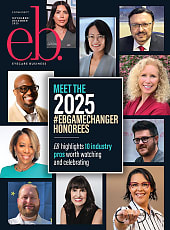
On Friday, Feb. 21, during Vision Expo East, The Vision Council (TVC) leaders shared their latest research and presented data and insights regarding what's to come for the industry in the year ahead. In addition, the TVC team provided information regarding the impact of new administration policies on trade and business, including how tariffs may affect the vision marketplace.
To learn more about tariff updates and their specific impact on the vision industry, EB spoke with Omar Elkhatib, TVC's senior manager of government relations.
EB: What are the specifics of the new tariff updates affecting the vision marketplace, and what can eyecare professionals in particular do to prepare?
Omar Elkhatib: The situation is fluid. President Trump has imposed 25% tariffs on all steel and aluminum coming into the United States. In addition, he has imposed a 10% tariff on all goods from China—that’s in addition to the existing China 301 duties that have been in place since 2018.
The president also threatened to impose 25% tariffs on all goods from Canada and Mexico, with a deadline in March to make that determination on whether those will happen, and he has ordered agencies to investigate plans for new reciprocal tariffs. Considering how trade policy continues to develop, with uncertainty around ultimate intent, eyecare professionals need to stay abreast of conditions while also building contingencies into their operating plans. Industry manufacturers should be conscious of export markets that could be impacted by retaliatory duties.
EB: Will ECPs need to raise prices to cover the increased costs associated with tariffs, and if so, how will this impact their competitiveness in the market?
OE: That decision is up to individual companies based on how tariffs affect their business, including if they will absorb or pass along the additional financial burden. However, businesses should expect to pay more for imported goods, whether raw materials, parts, components, or finished goods. Companies should also be mindful of forward contracts that could impose greater financial challenges.
EB: How might new tariffs disrupt the global supply chain for optical products, and what contingency plans might ECPs need to consider?
OE: Companies should anticipate how higher costs will impact their pricing. Freight costs will likely see an increase as companies try to beat the imposition of new tariffs, and transshipping will become a bigger issue, especially for Chinese goods. Reciprocal tariffs from other countries might also become a factor to consider.
Possible mitigation strategies include sourcing products from countries where free trade agreements are recognized. However, be cautious of simply moving goods from a tariffed country to one without. For instance, if you consider producing in a different country, but use Chinese inputs, those inputs must still undergo a substantial transformation in the country of final assembly. Otherwise, U.S. Customs and Border Protection might deem the finished product to be of Chinese origin and thus subject to the higher China 301 duties.
EB: TVC discussed tariff updates during the All-Member meeting at Vision Expo East. In addition to tariffs, what additional topics are top of mind right now for ECPs?
OE: In addition to tariffs, several regulatory matters will also be discussed at Vision Expo East—a benefit for our members. These include both California Prop 65 and PFAS regulations relating to chemical exposure, as well as web accessibility compliance considerations for those who maintain business websites.
Stay tuned for more updates from The Vision Council in EB's conference coverage.
Vision Expo East takes place Feb. 19-21 at the Orange County Convention Center in Orlando, FL. Keep up with the action from the event on Eyecare Business’s Facebook, LinkedIn, and Instagram, and see EB’s BIG Vision Expo East Guide for a curated selection of education and events here.



